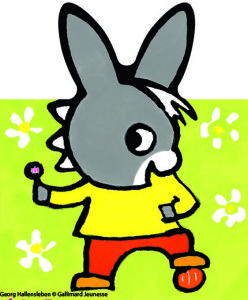
This week’s #langchat discussion about interpretive listening revealed that we language teachers are very diverse in the way we approach this skill, especially with novice learners. Although I reflected at length on the topic of assessing listening in an earlier post, I’d like to specifically address a few of the questions that came up during Thursday night’s discussion.
Question #1: What resources are appropriate for novice learners? While some teachers are hesitant to use authentic resources with early novices, I have found that first semester French 1 students can successfully interpret carefully selected authentic materials when given level-appropriate tasks. My go-to resource for these students are cartoon videos for the following reasons:
- These videos were made for novice language learners—young children in the target culture! As a result, the vocabulary and sentence structures are relatively simple and the linguistic input is supported by strong visual cues. This is exactly what our novice learners need.
- The wide selection of these videos ensures that there are several choices available for any theme we’ve included in our novice curriculum. My favorites for my Level 1 and 2 students are Trotro, Petit Ours Brun and T’choupi et Doudou, because of the broad range of topics covered and the comprehensibility. I also occasionally use Peppa Pig with my level 2 students. Although originally recorded in (British) English, the French translation was clearly intended for French-speaking children, so I do consider these to be authentic resources. However, the target culture would not, of course, be represented in these videos.
- Cartoons are very engaging to my students. They look forward to their turn at the computer and a few students have even mentioned that they have watched additional episodes of the series at home, “just for fun.”
- As authentic resources, these cartoon videos often integrate cultural products, practices and perspectives of the target culture. When Petit Ours Brun puts his shoes under the Christmas tree, his grandfather comments on the delicious turkey, and he wakes up to presents on Christmas morning, my students learn relevant cultural practices regarding Christmas celebrations in France.
Question #2: What types of tasks are appropriate for novice learners? I realized as I participated in Thursday night’s #langchat that I have interpreted ACTFL’s descriptors regarding interpretive listening differently than many of my colleagues. The Novice Mid (my goal for level 1) NCSSFL-ACTFL Can-Do Benchmark for interpretive listening reads, “I can recognize some familiar words and phrases when I hear them spoken.” If I understood my colleagues’ responses correctly, many of us may be assessing listening by having students list the words and phrases that they hear. Because it isn’t clear to me how this type of task would demonstrate interpretation/comprehension, I ask students to answer questions to show comprehension of the video, but phrase these questions in a way that the students can use previously-learned words/phrases (along with visual context clues) to respond. This year I am using a multiple choice format for my formative listening assessments using our district’s recently-adopted Canvas learning management system. Although I don’t feel that multiple choice is appropriate for many language tasks, this platform has the advantage of providing immediate feedback to my students. In addition, since creating and assessing them requires a minimal time commitment on my part, I am able to provide more opportunities for listening than I was using other task types. Lastly, this format provides students with additional context clues. Their listening is more purposeful as they are listening for a specific response, as well as to eliminate distractors. While I typically use open-ended question types on my IPA’s, these multiple choice quizzes, which the students complete individually at a computer, provide the majority of my formative listening assessments.
In order to save time, I create these quizzes directly in Canvas, which unfortunately makes them very difficult to share. For the purposes of this discussion, I’ve uploaded a Word document of screenshots from a quiz I made this morning for the video, Trotro et les cadeaux de Noel (https://www.youtube.com/watch?v=iRcv1pVaitY ). As this document shows, the questions that I’ve created enable these Novice Low-Mid students to demonstrate their ability to interpret this text using only previously-learned words and phrases and visual clues. While most of the items assess literal comprehension, I’ve included a few questions that require the students to make inferences and guess the meanings of new words using context clues. Here’s a quick explanation of my thought process for each question.
#1: While each of these questions would be appropriate to the context, my students will probably understand “pour moi” when they hear it. They will also be able to eliminate the 2nd choice, because they know the word for Santa. Although I’ve used the other question words in class, the students are not using them yet. I included them in the distractors to encourage the students to start thinking about how questions are asked.
#2: This question is a “gimme.” The students know the word for book and have visual clues as further support. I created the question to improve the students’ confidence, enable all students to have some “correct” answers, and to provide more context for further questions. As you can see, I write LOTS of questions, because I find the questions themselves provide important context and help the students follow along with the video.
#3: “Chouette” is a new word for these students, but it appears in a lot of children’s literature/videos and I think they’ll enjoy using it. The context should make the meaning of this word clear.
#4/#5: The students have learned the word “jeux-video” so I think they’ll get “jeu.” Also because Trotro also uses “jouer” I think they’ll understand it’s something to play with rather than listen to.
#6/#7 Students can answer by recognizing the previously-learned words “gros” and “belle.”
#8: Although this question does not assess listening comprehension (the word appears in written form), it does provide a contextualized way to introduce a new vocabulary word.
#9: The students can listen for the word “content” as well as eliminate the distractors based on previously-learned words.
#10: The students have heard “maintenant” repeatedly, but it hasn’t been formally introduced. If they don’t recognize it, they should still be able to eliminate the other choices.
#11: Although the students will not understand the entire sentence in which it appears, they should be able to answer this question by identifying the word “cadeaux.”
#12: I’m curious what my students will do with this inference-based question. They should recognize the phrase, “Moi, aussi” which should enable them to infer that Boubou got the same gift.
#13: The students should recognize the word “jouer” as well as be able to eliminate the distractors based on previously-learned vocabulary.
#14: The students should be able to use the visual context to guess the meaning of this new vocabulary.
#15: The phrase “c’est moi” should enable the students to choose the correct response for this one. As with several other items, I’ve included the transcription of the entire sentence to introduce new vocabulary—the verb “gagner.”
#16: Although my students won’t be able to use the linguistic content to answer this question, I’ve included it to encourage inference based on visual context clues.
#17: I’ll be curious how they do with this one. “Bateau” is an unknown word and although they’ve seen “mer,” I’m not sure they’ll pick up on it. Some might pick out “pirate” but I’ll be curious how many are able to answer this one correctly.
#18: The students have heard “rigolo” and this word even appears in Trotro’s theme song. In addition, they should be able to eliminate the distractors based on previously-learned vocabulary.
While there’s nothing especially innovative about this assessment format, after completing many similar tasks during their first semester of language study most of my level 1 students are pretty accurate when completing this type of formative assessment.
Question #3: How should interpretive listening be assessed? I did want to make a point about grading these formative assessments. Although I do my best to create questions that are mostly at the students’ current proficiency level, with a few items thrown in to encourage “stretch,” I rely heavily on my students’ results to determine how close I came to hitting this target. Therefore, I do not decide how to grade these assessments until I have data on how the class scored as a whole. In other words, this particular formative assessment will not necessarily by worth 18 points. If, for example, the highest score is 16, I might make this the maximum score. For teachers that do not record a score on formative assessments, this isn’t an issue of course. I only suggest that we expect and allow for student errors when assessing interpretive listening (even using objective evaluations) just as we do when assessing the other modes.
I’d love to hear from any of you who are willing to share your experiences and ideas about assessing listening with novice learners!
Image credit: www.gallimard-jeunesse.fr








